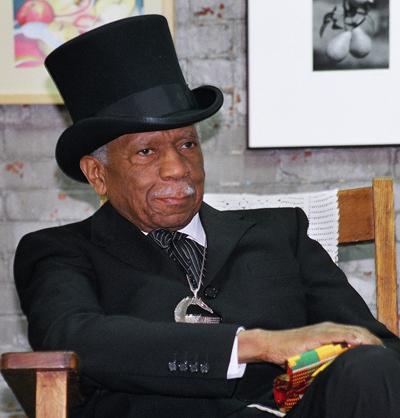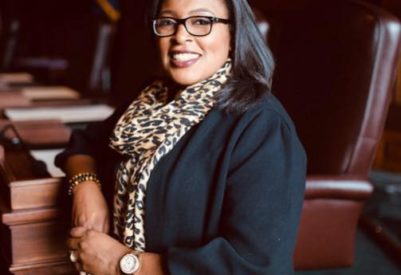
Southwest Tribune
Mr. Sankofa is what I refer to when I speak of Dr. David Anderson.
Sankofa is a word in the Akan Twi Fante languages of Ghana that translates to “Go back and get it.”
It is a reminder that the past must not be forgotten but should be acknowledged as we move into the future.
In other words, Sankofa represents the importance of learning from the past and using that to inform our actions in the future.
As an educator and civil rights activist but more so as a master storyteller, Dr. Anderson has enlightened an incalculable number of people about the prosperous societies, cultures and traditions of their African ancestors and the triumphs and struggles of African Americans to overcome slavery, segregation, and racism in America.
He was born in Cincinnati, Ohio, during the month of April on its 28th day in the year of 1930. After graduating from high school, he spent six years in the United States Air Force.
“The job responsibility of the squadron I was assigned was to collect the exposed film from B-29 airplanes that were being used to drop bombs over North Korea,” Dr. Anderson said. “When the bombers would return it was the squadron’s responsibility to collect the cans of film. The film was nine and a half inches wide and up to four-hundred feet,” he further stated. “We would process that film and make prints from it and use what was on the logs that the aviator had described in order to identify what was to be placed on the edges of the photographs.”
After his service in the military ended, he decided to enroll at the Rochester Institute of Technology (R.I.T.) to pursue a degree in the field Photography in 1958.
“I was a little interested in photography when I was in high school but this stuff, I did overseas had indicated to me it was a field that was more than beautiful people striking a nice pose,” Dr. Anderson said. “So, I was determined to see what I could do with it as a civilian. Ebony magazine and some white-operated magazines were making an appearance then, so that’s the way I went.”
But he also acknowledged that it was a rocky and rough ride because at that time R.I.T was not nearly interested in African Americans.
“Let me take you back,” he said.
“The day I arrived in Rochester and got off the overnight train and was walking through the depot, the handler of luggage said…….
[Where are you going Boy?]
“I told him I was twenty-six years old, who are you calling Boy?”
“He said hush Boy, before asking me where I was headed. “I replied that I was headed to the Rochester Institute of Technology. And he said…….
[I tell you what you do Boy. You put your things in this locker and you go out this door and turn right, you walk across the river.]
“I said walk across the river.”
[He said hush Boy and you will be one block from R.I.T.]
“I said sir. I said the Rochester Institute of Technology.”
[He said, hush Boy, you mean R.I.T.]
“When I got to the administration office, I was all fired up in a good way,” Dr. Anderson said. “When I walked in and described who I was and this man said he had no room for me. I said yea but… and he turned his back on me. I was furious,” he recalled. “I took a step toward his turn back and a cleaning lady said, [you got no self-esteem, I see.] So, I started to whirl on her but the first thing I saw was her beautiful housewives’ apron. It looks like the apron my momma or aunt Julie would wear and I paused long enough for her to get the message out. She said this is what you do sir,” Dr. Anderson continued. “You go out this door and turn left and go two blocks and you will arrive on Favor Street, then turn left of Favor and go to number sixty and ask for Ms. Morris and tell her Mrs. Gathers sent you.”
Dr. Anderson recalls stumbling out of there still angry but he knew that he had to try something, being he was in a strange place far away from home. When he got there, it was an African American lady in her little garden, no bigger than an automobile space, he recalled.
“I said hi, I am David Anderson, Mrs. Gathers sent me here and said you might have a room I could rent.” Mrs. Morris looked up at me and started fussing, asking why Mrs. Gathers had sent me there without calling her first, so I started to walk away and then Mrs. Morris said, [come on in son.]
During his stay at Mrs. Morris’s home, David met a number of people who resided on the west side of Rochester.
The main street in the area was called Clarissa Street and Black folks for the most part live in and around the streets that cut into it.
“This main drag in the city was a safe haven where people of color can go and be treated like human beings,’ Dr. Anderson said.
Meeting friends that share the same ideals of many young blacks in the early 1960s inspired him to begin organizing and participating in activist measures aimed to end segregation in public facilities.
The movement in North Carolina to picket and protest Woolworth Department Stores inspired Dr. Anderson and many others to picket the Woolworth store located in downtown Rochester, where meaning people of color were getting harassed and physically assaulted for entering the store to shop or get something to eat.
After graduating from R.I.T., Dr. Anderson decided to move to Syracuse, NY, but continued to visit Rochester once or twice a month.
“Another person that had befriended me in Rochester was Dr. Walter Cooper, who at the time was a research chemist for Eastman Kodak,” Dr. Anderson said. “He came down to Syracuse to meet with me, although I had a job, he persuaded me to come back to Rochester. As far as persuading me to come back, had a lot to do with his ability to hire me at Action for a Better Community (ABC), which is an anti-poverty agency in Rochester,” he said. “Dr. Cooper was granted a leave from Kodak to help draw proposals, before he could acquire the money to start the agency.”
At ABC, he became the administrator for its youth program, before becoming the associate director at the Urban League of Rochester several years later.
“While I was at the Urban League,” Dr. Anderson said. “We created something called Project Uplift, where 14- and 15-year-old kids, mostly Blacks and Puerto Ricans were selected to get jobs after school,” he noted. “The objective was getting them in a trajectory that would allow them to gain knowledge through experience about how to deal with life once they are out on their own.”
From there, Dr. Anderson was hired by the Rochester City School District (RCSD), where he oversaw a program called SPAN (School Parents Advisors for the Neighborhood).
“There must be a stronger and respected relationship between RCSD teachers and parents. And it is fundamental that our Black and Brown children receive cultural education regarding their history from the very beginning to the present day,” he said.
“Our ‘true’ history tells us we are somebody. We are not to be named and forecasted by those who had kidnapped and shackled our forebears.”





